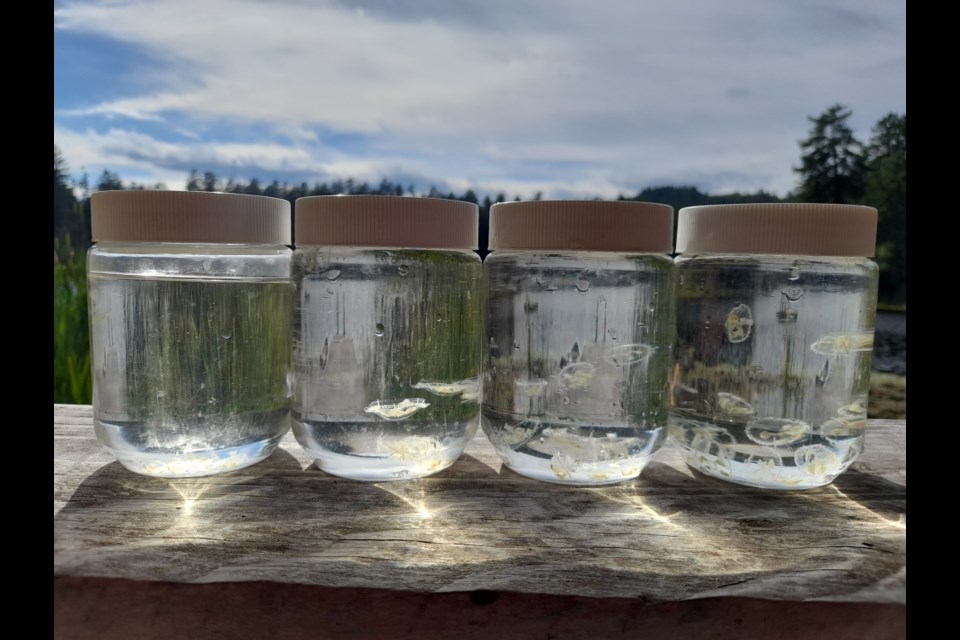For a few weeks every summer, a mysterious creature appears in some of the Sunshine Coast’s lakes: the freshwater jellyfish. Not much is known about the translucent thumbnail-sized marine life, which is why citizen scientists have taken up the task of collecting data and samples for UBC researchers.
Six volunteers — Brian Croft, Dr. Sharon Johnson, Tarren Mckay, Tony Pownall, Bob Stickely, and Dr. Bob Vroom — have barged equipment out onto Hotel Lake every four days this summer, dipped in plankton nets and captured samples in jars.
“The water is absolutely full of tiny, little creatures that we didn’t even know were there: plankton,” Croft said. “That was quite an eye opener for everybody here. They’re part of the foodchain for the jellyfish.” He’s noticed the jellyfish seem to follow the sun, then retreat to the cool depths quickly.
It all started when Croft read about Dr. Florian Lüskow research into the invasive jellyfish making its way into B.C. freshwater, and he knew he had to get in contact with the scientist. Hotel Lake, near Croft’s home, has the same jellyfish.
Lüskow is the only person in Canada researching the freshwater jellyfish. In 1990, freshwater jellyfish were first reported in B.C. when they were found in Victoria. About a decade later, people started reporting sightings on the Sunshine Coast in Klein, North, Katherine, Hotel and maybe Trout Lakes. “It wouldn’t surprise me if we found out one day that they’re in all of our lakes,” Croft said.
Lüskow is coming to the Coast to share information about ecosystems, food webs and jellyfish, as well as Hotel Lake in particular. It will be a sort of progress update on their research, full of local information. He came across the freshwater jellyfish while he was doing his doctoral studies of ocean jellyfish at UBC.
“I have been working with jellyfish for a long time, but seeing them in a lake, it’s very unusual, even for me,” he told Coast Reporter. They inspired many questions that Luskow hopes to answer through his postdoc research: Where do they come from? Are they barely surviving or thriving?
Freshwater jellyfish are very similar to ocean jellyfish (they likely share a common ancestor), in that both have tentacles and the umbrella-shaped body, live off smaller beings such as algae, and move around by currents. Human skin is too thick to be affected by freshwater jellyfish, so we don’t feel their sting.
“The tricky thing about these jellyfish is they can be numerous, but most of the time they are very small,” Lüskow said. So small, the citizen science project has started revealing we may not be able to see them with the naked eye for part or much of their lifecycle. They appear in late summer and early fall before disappearing again. “There’s lots of theories, but of course it’s difficult to test any of those,” he adds.
Teaming up with the Hotel Lake Advisory Association and lake residents “is a perfect combination,” Lüskow said. “This is an unprecedented effort in B.C., in all of Canada, and I’m very eager to see what comes out from the visual plankton samples.”
In July, Lüskow and his UBC supervisor travelled to Hotel Lake to train the volunteers on how to take accurate water samples that could reveal how many freshwater jellyfish are present and perhaps their impact on the ecosystem.
Because this jellyfish is considered invasive, Lüskow said they need to have a baseline understanding of the species before management or mitigation strategies can be developed. “This citizen science project is really one of the first steps to getting a much better understanding of how they are doing in British Columbia,” he said.
The species is subtropical and originates in China. Most of the lakes it invades are in warmer areas than B.C.: the continental U.S., Europe and southern areas of many of Canada’s provinces.
“It's very interesting how this warm species adapts to our template and in the winter very cool climate,” he said. Luskow’s work predicts that the distribution of freshwater jellyfish will increase with climate change in the next few decades.
On Sept. 7, the volunteers will perform their final station collection of the summer. It will be followed by a Sept. 9 presentation by Lüskow about the freshwater jellyfish at Sarah Wray Hall, starting at 2 p.m. (On the way to their presentation, Lüskow and his colleagues plan to stop at Trout Lake in Halfmoon Bay to collect samples to see if that lake also contains freshwater jellyfish.)
The samples the volunteers have collected will take up to six months to analyze, Lüskow said. After that point, he will decide if they need to repeat or extend the study or sample other lakes for comparison.
The Invasive Species Council of BC encourages people to Clean, Drain, Dry boats and equipment used in the province’s waterways to help reduce the spread of invasive species.



